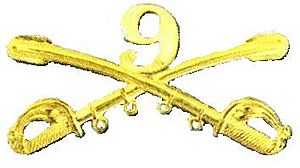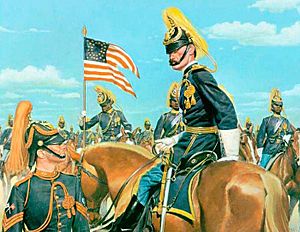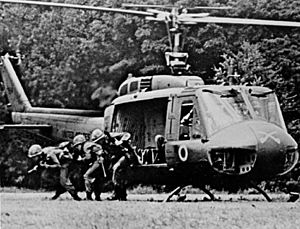9th Cavalry Regiment (United States) facts for kids
Quick facts for kids 9th Cavalry Regiment |
|
|---|---|
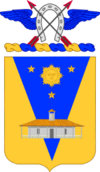
9th Cavalry Regiment coat of arms
|
|
| Active |
|
| Country | |
| Branch | |
| Type | Cavalry |
| Size | Regiment |
| Nickname(s) | "Buffalo Soldiers" |
| Motto(s) | "We Can, We Will" |
| Engagements | Indian Wars San Elizario Salt War Spanish–American War Philippine–American War Vietnam War Invasion of Panama Iraq War Operation Inherent Resolve |
| Commanders | |
| Notable commanders |
Edward Anderson Edward Hatch Adna Chaffee |
| Insignia | |
| Regimental distinctive insignia |  |
The 9th Cavalry Regiment is a special part of the United States Army. It's a cavalry regiment, which means it's made up of soldiers who used to ride horses and now use fast vehicles for scouting and fighting. This regiment is famous because it was one of the first four Army units made up of African-American soldiers. These brave soldiers were known as the "Buffalo Soldiers."
The 9th Cavalry has fought in many important wars, including the Indian Wars and the Spanish–American War. During the time of Westward Expansion, they helped protect early settlers and keep peace on the American frontier.
As of 2019, parts of the 9th Cavalry Regiment are still active. They are stationed at Fort Hood in Texas. These units work with the 1st Cavalry Division, performing important tasks like scouting and fighting.
Contents
- How the 9th Cavalry Began
- Important Missions and Battles
- Current Status
- Notable Members
- Images for kids
How the 9th Cavalry Began
The 9th United States Cavalry Regiment was officially created on July 28, 1866. A high-ranking officer, Major General Philip H. Sheridan, was given permission to form a regiment of African-American cavalry soldiers. This was a big step for the Army.
The regiment was formally put together in New Orleans, Louisiana, starting in September 1866. Its first leader was Colonel Edward Hatch. Soldiers joined for five years and were paid $13 a month, plus food, a place to live, and clothes. They soon earned the famous nickname "Buffalo Soldiers." The regiment's motto is "We Can, We Will."
Many of the first soldiers came from Kentucky and Louisiana. Their horses were brought from Missouri. In New Orleans, the soldiers stayed in old cotton presses, which were used as barracks. Sadly, an illness called cholera caused many deaths, and some soldiers left. The camp moved to a suburb called Carrollton. By March 1867, the 9th Cavalry had almost all its soldiers, about 885 men. They were then sent to San Antonio, Texas, for training.
Important Missions and Battles
Fighting in the Indian Wars
In July 1867, the 9th Cavalry was sent to western and southwestern Texas. Their job was to keep law and order along a long line of seven forts. They stayed in Texas for eight years, mostly out in the field. During this time, they often fought with Native American tribes like the Apaches, Kiowas, and Comanches. They also protected mail deliveries and rescued people who had been captured.
After Texas, the regiment moved to the New Mexico Military District from 1875 to 1881. Here, they helped build barracks and stables, cared for horses, and scouted for hostile Native Americans. They also escorted mail, explored new lands, and built roads. One important battle was the Battle of Tularosa in May 1880, where they fought Chiricahua Apache warriors led by Victorio.
Later, the 9th Cavalry moved to Fort Riley, Kansas, in 1881, and then to Fort Robinson, Nebraska, in 1885. They also fought in the Battle of Crow Agency in Montana in 1887. The regiment was also involved in patrolling during the Ghost Dance War with the Sioux, around the time of the Wounded Knee Massacre. They were the last regiment to leave the Pine Ridge Reservation in the winter of 1890-1891.
From Spanish-American War to World War I
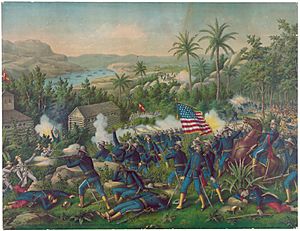
In 1898, the 9th US Cavalry Regiment fought bravely in the Spanish–American War in Cuba. They fought alongside Theodore Roosevelt's "Rough Riders" at the battles of Kettle Hill and San Juan Hill. After the war, they even served as Roosevelt's honor guard when he visited San Francisco.
The 9th Cavalry also played a unique role in protecting nature. In 1899 and 1904, they patrolled Yosemite National Park. They were some of the very first "rangers" of the park system.
Under General John J. Pershing, the regiment went to Mexico in 1916 to fight against Pancho Villa. During World War I, the regiment was stationed in the Philippines.
Teaching at West Point
From 1907 to 1947, a special group of 100 men from the 9th Cavalry served at the United States Military Academy (West Point). These experienced African-American non-commissioned officers were considered excellent riders. They taught future Army officers how to ride horses, perform mounted drills, and use cavalry tactics.
World War II and the Cold War
The 9th Cavalry was assigned to the 2nd Cavalry Division for World War II. However, the regiment did not fight as a single unit in that war. Instead, it was sent to North Africa in the Mediterranean region to provide soldiers for other units. It was officially closed down there in March 1944.
After the war, the regiment was renamed the 509th Tank Battalion in 1950. It was active for a few years before being closed again in 1956. In 1957, it was reorganized and renamed the 9th Cavalry again.
During the Cold War, different parts of the 9th Cavalry were assigned to various Army divisions. They were stationed in places like Korea, Europe, and different parts of the United States. Their roles included reconnaissance (scouting) and armored cavalry duties.
Vietnam War (Air Cavalry)
The 1st Squadron, 9th Cavalry (1-9 Cavalry) became an experimental "air cavalry" unit. This new way of fighting, called air assault, used helicopters to move soldiers quickly. These teams had aero-weapons (called "Reds"), aero-scouts ("Whites"), and aero-rifle (infantry, called "Blues").
Together, ground and air teams would patrol the Vietnam countryside to find the enemy. Once found, the infantry (Blues) would be dropped off by helicopter or move on foot to fight, with support from the air scouts and weapons. These teams earned the nickname "Headhunters." This was a very different way of fighting compared to traditional front lines.
During the Vietnam War, the 1st of the 9th Cavalry earned many awards for its bravery. It was one of the last units to leave Vietnam in February 1973.
Return to Fort Hood and Beyond
After Vietnam, the 1st Squadron, 9th Cavalry returned to Fort Hood, Texas. It served as a scouting squadron for the 1st Cavalry Division. In 1992, it was reactivated as the 1st Battalion, 9th Cavalry, becoming a mechanized infantry battalion.
Operation Just Cause in Panama
The 2nd Squadron, 9th Cavalry, was sent to Panama in December 1989 for Operation Just Cause. They helped with combat operations and later with humanitarian missions. Their attack helicopters and scout helicopters were among the first to arrive.
Peacekeeping and Modern Combat
The 1st Battalion, 9th Cavalry, was involved in operations to stop aggressive actions by the Iraqi Army in the 1990s. They were known for their skills in urban warfare (fighting in cities).
In the 21st century, units of the 9th United States Cavalry Regiment continue to provide important services. They perform RSTA (reconnaissance, surveillance, and target acquisition), which means they scout ahead of enemy lines to gather information. They also provide sniper and long-range surveillance teams.
These small Army units gather valuable real-time information about enemies, including their leaders and fighting abilities. This information helps intelligence agencies. The 9th Cavalry units have fought in the "Global War on Terror" in Afghanistan and Iraq. They have developed new ways to find, observe, and defeat enemies, just as they did in past wars.
The unit has received many awards for its bravery, including Presidential Unit Citations and Valorous Unit Awards. Many individual soldiers have also received awards for their courage.
Troop B in Iraq
Troop B ("Bloody Knife"), 9th Cavalry, was sent to Iraq in April 2003. They were part of the first combat operation for the 4th Infantry Division since Vietnam. They operated in many different areas of Iraq, performing tasks like clearing routes and scouting.
In October 2003, the soldiers of Troop B-9th Cavalry received their combat patches, which means they were authorized to wear their division patch on their right shoulder for fighting in Operation Enduring Freedom and Operation Iraqi Freedom. This troop became a quick reaction force for one of the largest supply bases in Iraq.
1st Battalion in Iraq
The 1st Battalion, 9th Cavalry Regiment (1-9th Cav), is stationed at Fort Hood, Texas. It's a combined arms battalion, meaning it has different types of fighting units. The unit is nicknamed the "Headhunters." It was even featured in the famous Vietnam War movie Apocalypse Now.
The 1st Squadron, 9th Cavalry Regiment (1-9th Cav), went to Iraq in September 2003 for Operation Iraqi Freedom. They were part of Task Force 1-9, which included infantry, combat engineers, and support units. During their first deployment, 124 Purple Heart medals were given to Task Force 1-9 soldiers, who fought in very dangerous areas, including the 2004 Battles of Sadr City.
In October 2006, the 1st Squadron, 9th Cavalry Regiment, went to Iraq again. They were stationed in Mosul and later Tal Afar. In June 2008, they deployed again, taking responsibility for important supply routes and towns. In August 2008, they built a forward operating base (FOB) near the Iranian border to stop illegal smuggling.
2nd Squadron
The 2nd Squadron, 9th Cavalry, was stationed in Munich, Germany, from 1963 to 1968, then moved to Fort Riley, Kansas. During Operation Desert Storm, it served as the 24th Infantry Division's scouting squadron. In 2003, it was reactivated as Troop B, 9th Cavalry, and served in Operation Iraqi Freedom I. This squadron was later closed down in October 2007.
4th Squadron
The 4th Squadron, 9th Cavalry, known as "Darkhorse," is stationed at Fort Hood, Texas. It's the armored reconnaissance squadron for the 2nd Brigade Combat Team, 1st Cavalry Division.
During Operation Iraqi Freedom 06-08, the Darkhorse went to Baghdad, Iraq. They secured the International Zone, which is a very important area with the U.S. Embassy and Iraqi government offices. They also conducted operations to fight against rebels in the Karkh District.
In 2009, the squadron went to Iraq again, this time to Kirkuk Province. They were responsible for security, stability, and rebuilding efforts in a large area. They worked with the Iraqi Army and police to train forces, improve services, and support the government.
The squadron deployed to Iraq a third time in 2011 and to Afghanistan in 2013. In 2017, they deployed to South Korea, and in 2019, to Poland.
5th Squadron
The 5th Squadron, 9th Cavalry, was located in Hawaii. It had ground troops and air troops, using OH-58A+ Kiowa scout helicopters and AH-1 Cobra attack helicopters. This squadron was later renamed in 1996.
6th Squadron
The 6th Squadron, 9th Cavalry, known as the "Saber Squadron," is assigned to the 3rd Brigade Combat Team, 1st Cavalry Division, and is stationed at Fort Hood, Texas. It was reactivated in 2003 and deployed to Iraq in October 2006. The 6-9 Cav was one of the last units to leave Iraq in December 2011.
Current Status
- The 1st Battalion is a Combined Arms Battalion (CAB) in the 2nd Brigade, 1st Cavalry Division, at Fort Hood, Texas.
- The 4th Squadron is the armored reconnaissance squadron of the 2nd Brigade, 1st Cavalry Division, at Fort Hood, Texas.
- The 6th Squadron is the armored reconnaissance squadron of the 3rd Brigade, 1st Cavalry Division, at Fort Hood, Texas.
Notable Members
Many brave and important people have served in the 9th Cavalry Regiment:
- John Hanks Alexander: The second African American to graduate from West Point.
- J. Franklin Bell: A Chief of Staff of the Army and a Medal of Honor recipient.
- Thomas Boyne: A Medal of Honor recipient.
- Benjamin O. Davis Sr.: The first African-American general officer in the U.S. Army.
- Matthias W. Day: A Medal of Honor recipient.
- John Denny: A Medal of Honor recipient.
- Robert Temple Emmet: A Colonel of the regiment and Medal of Honor recipient.
- LTG Paul E. Funk: A commander who led the 3rd Armored Division in Desert Storm.
- Clinton Greaves: A Medal of Honor recipient.
- Henry Johnson: An Indian Wars soldier and Medal of Honor recipient.
- George Jordan: A Medal of Honor recipient.
- Thomas Shaw: A Medal of Honor recipient.
- Gen. (Ret.) Robert M. Shoemaker
- Emanuel Stance: A Medal of Honor recipient.
- Capt. Jon E. Swanson: The only OH-6A pilot to receive the Medal of Honor.
- Augustus Walley: A Medal of Honor recipient.
- Moses Williams: A Medal of Honor recipient.
- Brent Woods: A Medal of Honor recipient.
- Charles Young: The third African American to graduate from West Point.
Images for kids
-
Corporal John Ross, Troop I, 9th Cavalry, at the Buffalo Soldier Memorial at Fort Bliss


